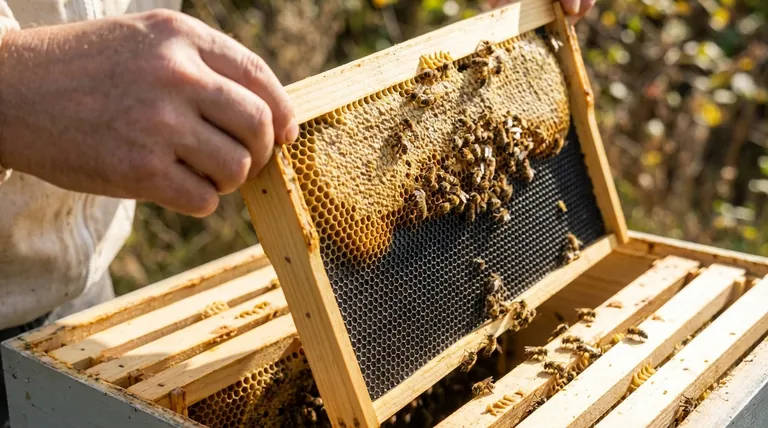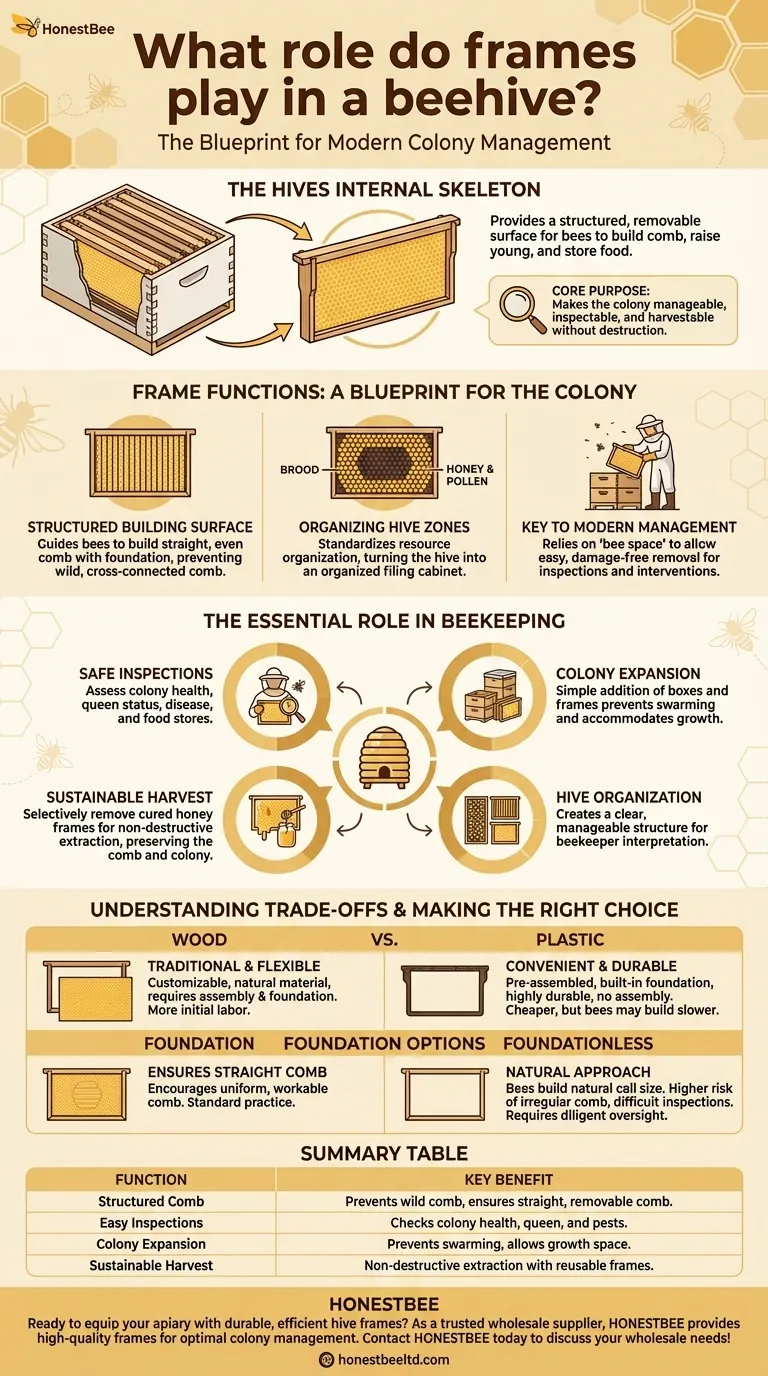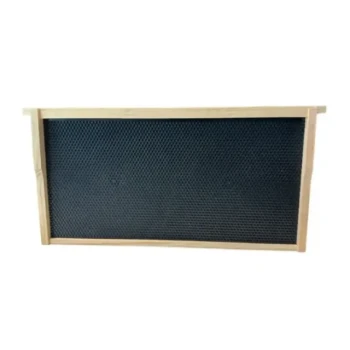At its core, a beehive frame is the internal skeleton of the hive, providing a structured, removable surface for bees to build comb. This comb is used to raise their young and store food, but the frame's true purpose is for the beekeeper: it makes the entire colony manageable, inspectable, and harvestable without causing destruction.
The essential function of a frame is not just to hold comb, but to make that comb removable. This single feature transforms the hive from a fixed, natural structure into an organized, modular system that a beekeeper can manage for the health of the colony and the harvesting of honey.

The Frame as a Blueprint for the Colony
Before the invention of the modern hive, accessing a colony meant destroying much of its comb. The frame system provides an orderly blueprint that respects the bees' natural instincts while giving the beekeeper necessary control.
Providing a Structured Building Surface
A frame is a rectangular structure, typically made of wood or plastic, that fits neatly inside a hive box. It holds a sheet of foundation—a thin plane of wax or plastic embossed with a honeycomb pattern.
This foundation serves as a guide, encouraging bees to build straight, even comb within the confines of the frame. Without this guidance, bees would build "wild comb" that connects multiple surfaces, making removal impossible without tearing it apart.
Organizing the Hive's "Rooms"
A bee colony naturally organizes its resources. With frames, this organization becomes standardized and easy to read.
Frames allow the bees to create distinct zones for different purposes. The queen lays eggs in the brood area, while worker bees store pollen and nectar (which becomes honey) in surrounding frames. This turns the hive into an organized filing cabinet that the beekeeper can easily interpret.
The Key to Modern Hive Management
The ability to easily lift a frame out of the hive is the principle that underpins almost all modern beekeeping practices. This concept is known as bee space, a precise gap left around the frames that prevents bees from sealing them together with wax.
Enabling Safe and Easy Inspections
Removable frames allow a beekeeper to perform regular inspections to assess the colony's health.
By pulling out individual frames, a beekeeper can check if the queen is laying eggs, look for signs of disease or pests like varroa mites, and ensure the colony has adequate food stores to survive.
Facilitating Colony Expansion
As a colony grows, it needs more space. Frames make this expansion simple and methodical.
Beekeepers can add new boxes filled with empty frames, giving the bees more room to build comb, store honey, and expand the brood nest. This helps prevent swarming, a natural process where a colony splits because it has run out of space.
Allowing for Sustainable Honey Harvests
Frames revolutionize the honey harvest. Instead of crushing comb and harming bees, the beekeeper can selectively remove frames that are full of cured honey.
These frames are then taken to be extracted, and the empty frames can be returned to the hive for the bees to refill. This is a sustainable, non-destructive process that preserves the colony and its workforce.
Understanding the Trade-offs
Choosing a frame type is one of the first decisions a beekeeper makes. The choice involves trade-offs between convenience, cost, and beekeeping philosophy.
Wood vs. Plastic Frames
Wooden frames are traditional and highly customizable. Beekeepers must assemble them and install a separate foundation. They are favored for their natural material but require more initial labor.
Plastic frames often come as a single, molded piece with the foundation built-in. They are extremely durable, require no assembly, and are often cheaper, but some beekeepers believe bees are slower to build comb on them.
The Role of Foundation
Most beekeepers use foundation to ensure straight, workable comb. However, some prefer foundationless beekeeping.
Going foundationless allows bees to build comb in whatever cell size they naturally prefer. The trade-off is that they are much more likely to build irregular, cross-connected comb if not managed carefully, which can make inspections difficult.
Making the Right Choice for Your Goal
Your choice of frame should align with your beekeeping goals, budget, and how much time you want to invest in assembly and maintenance.
- If your primary focus is convenience and speed: Pre-assembled, single-piece plastic frames are the most efficient option to get a hive started quickly.
- If your primary focus is tradition and flexibility: Unassembled wooden frames allow you to choose your preferred foundation type (wax or plastic) and are the classic standard.
- If your primary focus is natural beekeeping: Foundationless wooden frames give bees the most control, but require more diligent oversight to ensure straight comb.
Ultimately, understanding the function of the frame is the first step toward understanding the language of your hive and becoming a successful beekeeper.
Summary Table:
| Function | Key Benefit for Beekeeper |
|---|---|
| Structured Comb Building | Prevents wild comb, ensures straight, removable honeycomb. |
| Easy Hive Inspections | Allows for checking colony health, queen status, and pests. |
| Colony Expansion | Helps prevent swarming by easily adding space for growth. |
| Sustainable Honey Harvest | Enables non-destructive honey extraction with reusable frames. |
Ready to equip your apiary with durable, efficient hive frames? As a trusted wholesale supplier to commercial apiaries and distributors, HONESTBEE provides high-quality wooden and plastic frames designed for optimal colony management and productivity. Let our expertise help you build a stronger, more manageable operation. Contact HONESTBEE today to discuss your wholesale needs!
Visual Guide

Related Products
- Assembled Wooden Bee Frames with Plastic Foundation for Durability and Convenience by HONESTBEE
- Plastic Bee Frame Beekeeping Hive Frames for Wholesale
- Assembled Wooden Bee Frames with Beeswax Foundation Ready to Use by HONESTBEE
- HONESTBEE Wired and Assembled Wooden Bee Frames Foundation for a Thriving Hive
- 7 x Auto Bee Flow Hive Frames Plastic Beekeeping Hive Box Supplies
People Also Ask
- Can old bee frames be reused? Weighing the Risks vs. Rewards for Your Hive
- What materials are used to make beehive frames? Wood vs. Plastic for Your Apiary
- What are the options for frames in a beehive? Choose Between Wood & Plastic for Your Hive
- Can I reuse old frames? A practical guide to saving money and reducing waste
- What materials are commonly used for beehive frames? Wood vs. Plastic for Your Apiary



















